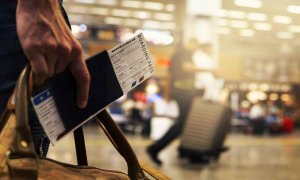Role and Importance of Information Technology in Aviation industry: Whenever there is a voting for the most popular public transport mode it is the aircrafts that win. Aircraft these days are an extension of the technology dependency that human race is suffering from. The three symbols that define the aviation in the modern lingua are the speed efficiency, comfort and the safety.
But nevertheless as much claimed as the safest mode still flight accidents are fatal and rock the world every now and then. Things cannot be blamed to the technology, as there are other forces like human touch, geographical conditions that are beyond human capacities and play their dynamics in aeronautics.
Thus it has to be remembered that how much we try hard to develop technology but we cannot be hundred percent sure of its success. The airports were dwelling in with more passengers’ often more than their own capacity it was the technology that came to rescue and the airport management understood that this unending increase in traffic can only be managed with technological aids.
The airlines want to progress, increase revenue and business, bring in more machines and automation but they do not want to lose their touch with their customers. Innovation management along with new partnerships between the IT giants and the aviation players will be forged, which will define the future.
The prime focus of the airlines has to be on the internal protocol technologies and areas like end to end services and airport integration can also not be neglected.
EARLY YEARS AND THE NEW TECHNOLOGICAL AREAS OF THE AIRLINES INDUSTRY
More and more functionality has been added with regards to the CRM or customer relationship management. Every aspect like enquiry, check in desk boarding has been touched by technology revolution. The focus of air carriers has also been their internal systems, which needed integration too.
These were areas, which were ignored for too long and needed dire attention in the modern times. Distribution channels of the airlines sectors also were requisitioned and revisited. The sales departments moved towards the e-commerce, which was growing at a fast pace and looked promising. Rom the generalist approach the approach was shifted towards the specialist one which included
“CONTENT MANAGEMENT” which focused on a customer friendly site movements.
“BUSINESS INTELLIGENCE TOOLS” from superficial knowledge handling to move deeper into the knowledge domain.
“PERSONALISED SOFTWARE” Each visitor or customer will feel that the site has been tailor-made as per his/her choice.
These solutions, which are mentioned above, may have not been tried and tested by all the players but many airlines have started toying with them. The airlines are developing the technology and their business around these frameworks. Of course cost management is one of the most quoted business challenge that these aviation players have been stating.
Once certain processes are developed then their new usages in other areas could also be found out. And be integrated into overall e-commerce platform. A simple example could be the catering activities which are defined by streamlining, quick communication with other vendors and business partners.
TECHNOLOGY OF INTERNET
The internet has been the revolutionary object in the technological domain of an airline. It could lead aviation industry to work with effectiveness and safety, that too yielding cost effectiveness. There are certain areas where the airlines fight for technology with their competitors but in certain areas it serve the common purposes of these aviation players.
The two strategic goals in front of the airlines in the modern era are is to attain proximity to the customers and become cost efficient as much as possible. The pace at which the technology is changing is too high and hence to strategize for the airlines is difficult and challenging.
Role and Importance of Information Technology in Aviation industry
As we enter 2017 the future seems both exciting and worrying. As the technology sector moves forward faster than any other sectors can keep up, issues such as cyber security becomes more and more challenging at a faster rate. Some of the insights provided by IATA regarding such problems are:
DRONES AND CHATBOTS THE NEW ERA TECHNOLOGY FOR AVIATION INDUSTRY
Augmented reality (AR) – is more likely to penetrate the airlines and airports in future to support ground operations by the use of AR.
- Chat bots or simply known as Artificial Intelligence, which could act as a single gateway for passengers.
- Indoor positioning system or beacon technology- beacon makes it possible for airports and airport venders to know where people are and to send them relevant personal information like gate number, baggage carousal, flight status, or even a passenger’s favorite coffee shop.
Though these new advance technology may be used in future to make aviation sector more convenient and advanced.
CONTRIBUTIONS OF TECHNOLOGY IN AVIATION INDUSTRY
Social CRM (customer relation management) – the use of social media has contributed a lot as it proved to be a crucial element in customer relationship management. Platforms like Twitter and Facebook have opened up new channels through which companies can engage their clients and foster customer loyalty.
- Digitalization is another factor which has made the work of airlines easy by the adoption of electronic formats for key regulatory and tracking documents.
- Use of advanced and highly equipped passengers service units like overhead PSUs and armrest PSUs along with wireless headgears and tablets instead of backrest TVs for entertainment of the passengers.
- For comforts many airlines are also planning to install new technological equipment’s such as automated passenger seats for comfortable flights where passenger do not have to struggle with the positioning of the seat for comfort.
- Navigation technology is another such contribution of technology made in aviation industry.
- Highly secured software to protect the private information of the company and the passenger both is another such or rather very important contribution of technology.
DEPARTURE CONTROL SYSTEMS
DCS or Departure Control System is generally an integrated multiple host system or solutions for automatic check in, boarding and load control/management. They are offered by various brands and can have stood the test of time. It is rich in terms of functionality and has proven their worth on all kinds of models and crafts.
It is a boon for ground handlers and support multi airlines. It also supports the alliance network and the priority aspect of passenger handling. Some of the common features of these DCS are that they are in sync with the standard IATA messages. They not only focus on airlines formalities at the airport but also at the governmental requirements like immigrations and customs.
Also read Indian Airports with IATA Codes
These DCS s are trained to accept manifest of the passengers from any kind of reservation systems. These DCS can interact with a variety of e-ticketing data. They are equally equipped to handle interlines and through check ins. Often the DCSs are connected to reservation systems so that revenues can be maximized.
Role and Importance of Information Technology in Aviation industry
CHANGING TECHNOLOGY IN CHECK INs
1. WEB CHECK IN
The passengers can check in through the websites of the airlines on their computers, laptops or hand held devices. The passenger can select a seat online, save or take a copy of their boarding cards that too within the comfort of one’s home or workplace. In case there is no check in luggage then the passenger can directly report to the governmental formalities.
2. CHECK IN VIA KIOSKS
Kiosks are one of the finest examples of self-service at the airports. These kiosks help the passengers to check in themselves and even obtain a copy of their boarding pass. In case the check in baggage is there then the passenger has to report in advance otherwise the passenger can directly move to the security areas.
3. TELE CHECK IN SERVICES
The check in can also be done through telephone. Generally airlines have a toll free numbers which when dialed take you through menus and one can complete a check in on phone itself. Generally initially airlines tried this with only business and first class passengers and frequent flyer, members but later it was extended to all.
Generally these facilities are available twenty four seven. In tele check in one has to collect the boarding passes from the counters. In case of issues the toll free numbers provide all possible assistance.
Also read Airport Lounges
OTHER NEW TECHNOLOGY INNOVATIONS AT AIRPORTS GLOBALLY
Technology is ruling the aviation sector not only in terms of crafts and planes but at the airports too.
Cork Airport pioneered with Flightradar24 to offer an app where real time tracking of craft can be done. The travelers can get the exact location of the craft arriving and taking off from this Irish airport. Just at a click the passenger can obtain information like aircraft’s altitude, equipment, speed, route, and total distance travelled.
Tiger air Australia’s efforts to provide ipad check in have provided a revolution at airports. The check-in agents have ipads in hand and this provides a lot of mobility to the staff. The staff can roam freely and check in the guest at cafeterias, souvenir shops, anywhere away from the traditional check-in desk.
This provides a break from queues too. These ipads are special as they have an app named “MAX AIRPORT BY LEVARTI”. Fully automated self-service bag drop systems are a new rage with the airlines. Senai International Airport has this facility from Air Asia, which is a self-service bag drop solution – SCAN & FLY.
The passengers have option of printing their own bag tags at the check-in kiosks. The passengers need to scan their boarding pass with a handheld scanner and if their bags are found in order in terms of size and weight both the kiosk will accept the baggage automatically. This is one of the first efforts for unmanned check in and it hardly takes three minutes approx. to complete the check in process that too unmanned.
Abu Dhabi’s document authentication is an innovation which can speed up the entry process. As soon as the passenger put their boarding pass for scanning (be it machine, home printed) the data is send for validation. The information is sent for validation to the airline’s DCS. The information is put in front of the security agent on a GUI.
This will help quick validation and verification of passenger documentation which will speed up and be efficiently done. Aruba Airport has its story of “Happy Flow Biometric” where facial recognition technology will be used for the identification of a passenger at check-in, bag drop, border control and aircraft boarding.
Once the passport and facial features of passenger are linked together at the first check-in point the passenger does not have to multiple times display their boarding cards and passports. Customer service robots are an option for passenger airport experience. This is continuation to online check INS, home printed and self bag tags, Self service kiosks, and mobile boarding cards.
This if become successful will remove the much talked about human touch. Geneva airport has introduced the concept of robots. The airport has collaborated with Blue Botics where the customer service agent services are provided by robots for offering directions and to lead the passengers there. Initially the robots were deployed in baggage reclaim area where they can be used in optimum.
The robots can guide passengers for baggage collection, foreign exchange counters, washrooms and train ticket counters. Passengers touch the screen select the service they want to use and they are lead by a robot to the desired service.
The debate for robots versus humans does exist. As the airport environment is too stressful and humans by their humane touch provide comfort and relaxation. So the technology experts are of the view that the robots will complement the humans and will not replace them.
Role and Importance of Information Technology in Aviation industry
Also read World Major Airports with Official Codes





